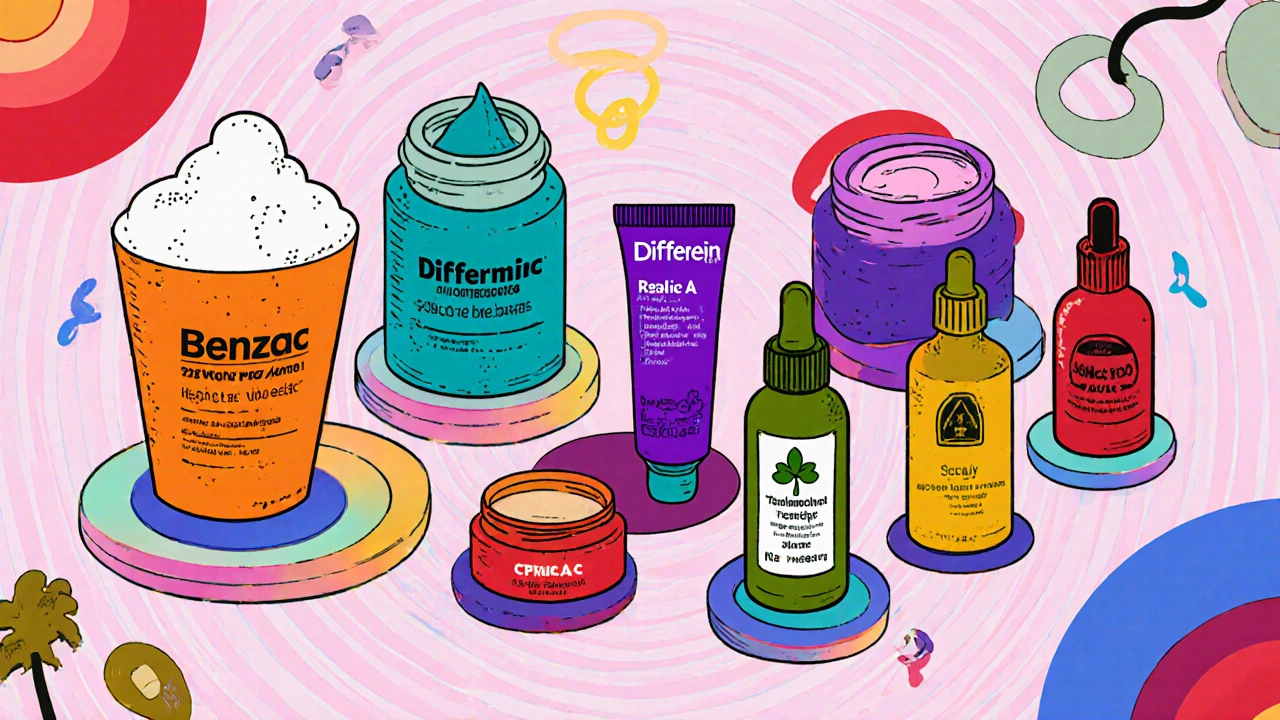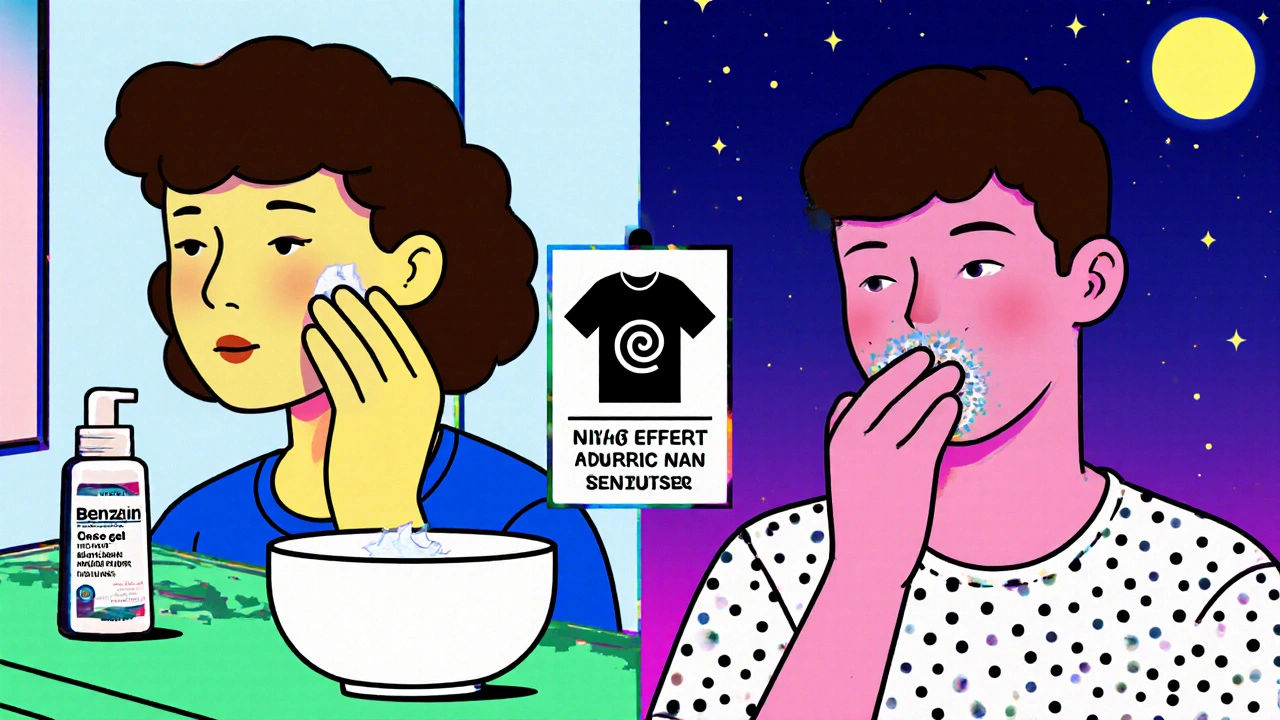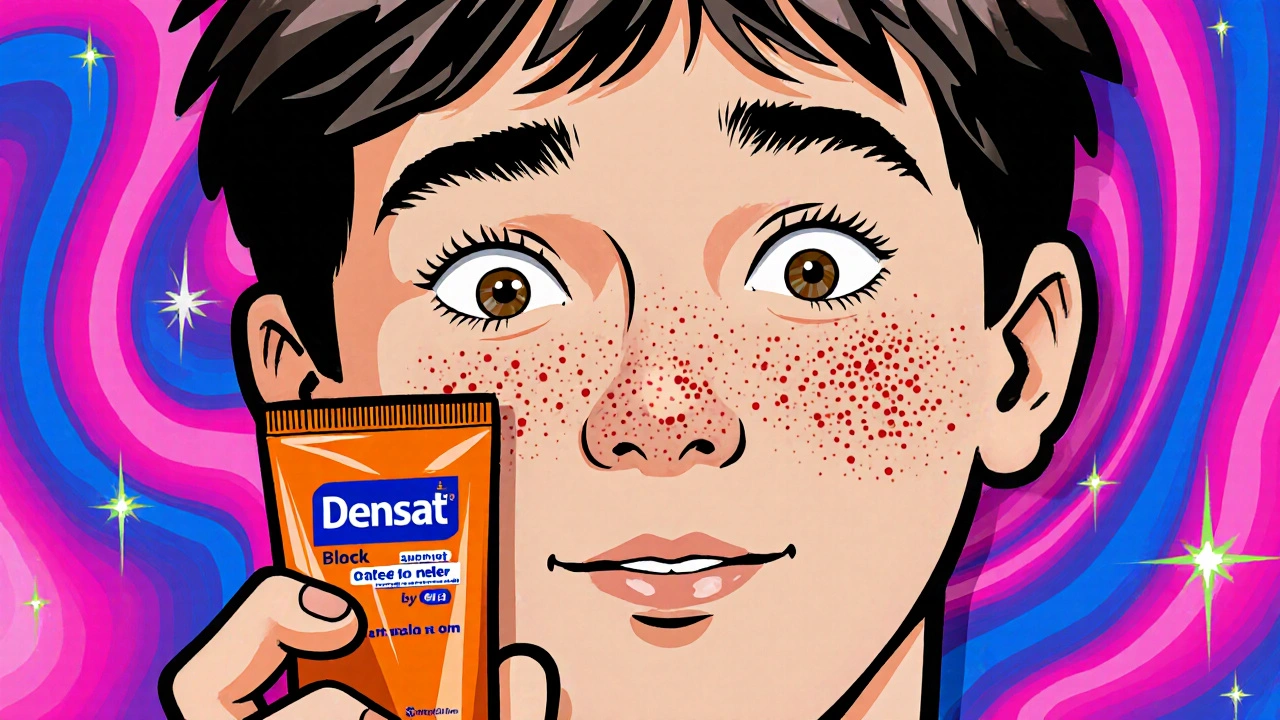Acne Treatment Finder
Find Your Best Acne Treatment
Answer a few quick questions to get personalized recommendations for your acne treatment.
Your personalized recommendations will appear here...
Key Takeaways
- Benzac (benzoyl peroxide) is fast‑acting, inexpensive, and works well for mild to moderate acne.
- Retinoids like Differin and Retin‑A target cell turnover, making them better for comedonal acne.
- Salicylic acid and azelaic acid are gentler options for sensitive skin.
- Antibiotic combos (e.g., clindamycin) are useful for inflammatory lesions but risk resistance.
- Cost, side‑effects, and skin type should drive the final choice.
What is Benzac?
When it comes to treating stubborn breakouts, Benzac is a brand name for benzoyl peroxide, a topical antioxidant that kills acne‑causing bacteria and unclogs pores. It’s been sold over the counter for decades and comes in gels, creams, and washes ranging from 2.5% to 10% strength.
People love it because it works quickly-most notice less redness within a few days. The trade‑off is that it can be drying and may cause a temporary bleaching of clothing or hair.
How Benzac Works
benzoyl peroxide kills Propionibacterium acnes by releasing oxygen deep in the follicle. This oxygen‑rich environment is hostile to the anaerobic bacteria that fuel acne. At the same time, the compound breaks down the keratin plug that forms a whitehead, turning it into a softer, less visible blemish.
Because its mechanism is purely chemical, resistance is rare-something you don’t get with many antibiotics. However, the oxidative action also irritates the skin barrier, which is why many users start with a low concentration and build up.

Top Alternatives Overview
Below are the most common acne alternatives you’ll see on pharmacy shelves or prescribed by dermatologists. Each has its own strengths, drawbacks, and ideal skin‑type match.
Differin is the over‑the‑counter name for adapalene, a third‑generation retinoid that promotes cell turnover and reduces inflammation. It’s especially good for blackheads and whiteheads. The downside? It can cause initial redness and flaking, so moisturizers are a must.
Retin‑A (tretinoin) is a prescription‑only retinoid that works similarly to adapalene but is more potent. Dermatologists often reserve it for severe comedonal acne or for patients who need faster results. Side‑effects can be stronger-think peeling, sun sensitivity, and occasional burning.
Salicylic Acid is a beta‑hydroxy acid (BHA) that exfoliates inside the pore, dissolving oil and dead‑skin buildup. It’s milder than benzoyl peroxide and works well for people with oily skin who can’t tolerate heavy drying.
Azelaic Acid is a naturally occurring dicarboxylic acid that kills bacteria, reduces keratin buildup, and lightens post‑acne marks. It’s a solid choice for sensitive or rosacea‑prone skin, though it tends to be pricier.
Clindamycin is a topical antibiotic often paired with benzoyl peroxide or a retinoid to target inflammatory lesions. Overuse can lead to antibiotic resistance, so doctors usually prescribe it for short cycles.
Tea Tree Oil is an essential oil with antimicrobial properties that some people use as a natural alternative to chemical acne meds. Results vary widely, and the oil can irritate sensitive skin if not diluted.
Sulfur has been used for acne since the 1800s. It absorbs excess oil and has mild antibacterial action. Modern formulations are less messy, but the smell can be off‑putting.
Niacinamide is a form of vitamin B3 that reduces inflammation, improves barrier function, and can reduce the appearance of pores. It’s usually added to moisturizers or serums rather than used as a stand‑alone acne treatment.
Side‑by‑Side Comparison
| Attribute | Benzac (Benzoyl Peroxide) | Differin (Adapalene) | Retin‑A (Tretinoin) | Salicylic Acid | Azelaic Acid | Clindamycin |
|---|---|---|---|---|---|---|
| Formulation | Gel, cream, wash (2.5‑10%) | Cream/gel (0.1% OTC, 0.3% prescription) | Cream/gel (0.025%‑0.1%) | Liquid, pad, cleanser (0.5‑2%) | Cream, gel (15‑20%) | Gel, lotion (1%) |
| Mechanism | Oxidative bacteria kill, keratin plug breakdown | Retinoid‑induced cell turnover | Potent retinoid cell turnover | Keratin exfoliation inside pores | Antibacterial + keratin normalization + pigment reduction | Protein synthesis inhibition in bacteria |
| Best for | Mild‑to‑moderate inflammatory acne | Comedonal acne, mild inflammatory | Severe comedonal & inflammatory acne | Oily skin, blackheads, sensitive skin | Rosacea‑prone, post‑acne hyperpigmentation | Acute inflammatory flare‑ups |
| Typical Side Effects | Dryness, peeling, bleaching of fabrics | Redness, flaking, sun sensitivity | Intense peeling, dryness, photosensitivity | Mild stinging, dryness | Itching, mild burning | Local irritation, rare allergic reaction |
| Cost (US $) | ~$8‑$15 for 3 oz | $12‑$20 | $30‑$80 (prescription) | $5‑$12 | $20‑$45 | $10‑$25 |

When to Choose Benzac
If you’re battling a breakout that’s mostly red papules and pustules, Benzac is usually the first line of defense. Its antibacterial action hits the main cause of inflammation, and the keratolytic effect helps clear clogged pores fast.
Start with a 2.5% gel applied once daily to clean, dry skin. If you tolerate it well after a week, you can bump up to 5% or use it twice a day. Pair it with a gentle moisturizer that contains ceramides to keep the skin barrier happy.
People who have oily skin, a history of good response to over‑the‑counter products, or who want a budget‑friendly option often stay with Benzac for the long haul.
Common Pitfalls & Practical Tips
- Don’t over‑apply. A pea‑sized amount per affected area is enough; more just increases irritation.
- Apply to dry skin. Moisture can dilute the peroxide and reduce its effectiveness.
- Avoid mixing with strong acids (like high‑strength salicylic or glycolic acid) in the same step. Use them at different times of day.
- Watch your laundry. Benzac will bleach towels, pillowcases, and dark clothing if you don’t rinse them well.
- If you notice excessive burning, cut back to every other day for a few days, then re‑introduce gradually.
Frequently Asked Questions
Can I use Benzac and a retinoid together?
Yes, but stagger them. Apply Benzac in the morning and a retinoid (like Differin) at night. This avoids excessive irritation while letting both work.
How long before I see results?
Most people notice reduced redness within 3‑5 days. Visible reduction in lesion count typically shows up after 2‑4 weeks of consistent use.
Is Benzac safe during pregnancy?
Benzoyl peroxide is classified as Category B by the FDA, meaning animal studies show no risk but there aren’t enough human studies. Most dermatologists advise using the lowest effective concentration and limiting the area.
Why does my shirt get white spots after using Benzac?
The peroxide can bleach fabrics, especially cotton. Let the product fully absorb before dressing, and wash clothing separately if you suspect staining.
What’s the difference between Benzac and generic benzoyl peroxide?
Chemically they’re the same. The difference is brand packaging, inactive ingredients, and price. Some people find the Benzac gel less greasy than generic creams.
Can I use Benzac on my face and body?
Absolutely. Just apply a thin layer to each area. For the body, a wash‑off product (like a 5% cleansing gel) works well because you can rinse after a few minutes.
Bottom line: Benzac remains a solid, cost‑effective starter for many acne sufferers, but the best regimen often mixes it with a retinoid, an acid, or a targeted antibiotic depending on your skin’s needs. Pick the alternative that matches your skin type, your budget, and how quickly you want results.

Olivia Harrison
October 24, 2025 AT 19:12Starting with a low‑strength Benzac gel (2.5%) and a gentle, non‑comedogenic moisturizer can really keep the dryness in check.
Apply the gel to clean, dry skin once a day and watch how the redness calms within a few days.
If your skin tolerates it, you can bump up to 5% or add a second application in the evening.
Remember to use sunscreen during the day because benzoyl peroxide can make your skin more photosensitive.
the sagar
November 3, 2025 AT 00:25Benzac is a Western pharma hack don’t trust the global pharma agenda.
Grace Silver
November 12, 2025 AT 06:38The battle against acne is as old as humanity itself. Benzac offers a quick spark of oxygen that the bacteria cannot survive. Its simplicity hides a complex chemistry that turns pores into hostile ground. Many users celebrate the rapid drop in red bumps within days. Others warn of the inevitable dryness that follows the oxidative assault. The trade‑off forces a mindfulness about moisturizers and barrier repair. In my experience the mind often overreacts to the surface irritation. Yet the deeper truth is that inflammation fuels the cycle of lesions. By cutting that fire early the skin can reset its natural rhythm. The cost of a small tube is a fraction of a dermatologist visit. Some argue that retinoids are more elegant but they demand patience. Salicylic acid whispers to oily skin but lacks the bacterial kill. Azelaic acid soothes and brightens but sits at a higher price point. The choice ultimately mirrors the individual’s priorities and skin type. Embracing Benzac as a starter can be a pragmatic step in the larger journey.
Clinton Papenfus
November 21, 2025 AT 12:52Esteemed readers, the integration of Benzac within a culturally aware regimen reflects both scientific rigor and personal heritage. By respecting the skin’s barrier while embracing modern dermatologic advances, one honors tradition and progress. Let us proceed with disciplined consistency and measured optimism.
Zaria Williams
November 30, 2025 AT 19:05Okay so i tried the 5% Benzac after reading the post and omg it actually worked faster than i thought lol.
First night my face felt a little tingly but that’s normal.
By day three the red spots were way less and my skin felt smoother.
If ur skin is super sensitive try the 2.5% gel first and use a heavy moisturizer.
Also watch out for bleach stains on your pillowcase – i had a white spot on my shirt lol.
Overall definetly worth the hype if u can handle a bit of dryness.
ram kumar
December 10, 2025 AT 01:18The drama of acne treatments is a circus and Benzac is the clown that burns the tent.
Its brilliance lies in its ruthless efficiency.
Melanie Vargas
December 19, 2025 AT 07:32Hey skin‑warriors 🌟 remember that consistency beats intensity every time.
Pair Benzac with a good moisturizer and sunscreen and you’ll see steady improvement 🌞.
Don’t forget to be kind to your skin, it’s doing its best! 😊